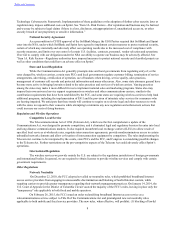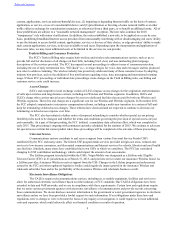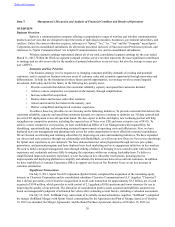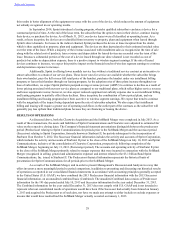Sprint - Nextel 2014 Annual Report Download - page 20
Download and view the complete annual report
Please find page 20 of the 2014 Sprint - Nextel annual report below. You can navigate through the pages in the report by either clicking on the pages listed below, or by using the keyword search tool below to find specific information within the annual report.
Table of Contents
18
lost, disclosed, accessed, used, corrupted, destroyed, or taken without the subscribers’ consent. Cyber attacks, such as the use
of malware, computer viruses, denial of service attacks, or other means for disruption or unauthorized access, have increased
in frequency, scope, and potential harm in recent years. We also purchase equipment and software from third parties that
could contain software defects, Trojan horses, malware, or other means by which third parties could access our network or
the information stored or transmitted on such network or equipment.
While to date, we have not been subject to cyber attacks or other cyber incidents which, individually or in the
aggregate, have been material to our operations or financial condition, the preventive actions we take to reduce the risk of
cyber incidents and protect our information technology and networks may be insufficient to repel a cyber attack in the future.
In addition, the costs of such preventative actions may be significant, which may adversely affect our results of operations.
Any major compromise of our data or network security, failure to prevent or mitigate a loss of our services or network, our
proprietary information, or our subscribers’ information, and delays in detecting any such compromise or loss, could disrupt
our operations, impact our reputation and subscribers' willingness to purchase our service, and subject us to significant
additional expenses. Such expenses could include incentives offered to existing subscribers and other business relationships
in order to retain their business, increased expenditures on cyber security measures and the use of alternate resources, lost
revenues from business interruption, and litigation, which could be material. Furthermore, the potential costs associated with
any such cyber attacks could be greater than the insurance coverage we maintain.
In addition to cyber attacks, major equipment failures, natural disasters, including severe weather, terrorist acts or
other disruptions that affect our wireline and wireless networks, including transport facilities, communications switches,
routers, microwave links, cell sites, or other equipment or third-party owned local and long-distance networks on which we
rely, could disrupt our operations, require significant resources to remedy, result in a loss of subscribers or impair our ability
to attract new subscribers, which in turn could have a material adverse effect on our business, results of operations and
financial condition.
If we are unable to improve our results of operations and as we continue to modernize our networks, we may be required
to recognize an impairment of our long-lived assets, goodwill, or other indefinite-lived intangible assets, which could have
a material adverse effect on our financial position and results of operations.
As a result of the SoftBank Merger and the remeasurement of assets acquired and liabilities assumed in
connection with the transaction, Sprint recognized goodwill at its estimate of fair value of approximately $6.6 billion, which
has been entirely allocated to the wireless segment. Since goodwill is reflected at its estimate of fair value, there is no excess
fair value over book value as of the date of the close of the SoftBank Merger. Additionally, we recorded $14.6 billion and
$41.7 billion of long-lived assets and indefinite-lived intangible assets, respectively, as of the close of the SoftBank Merger.
We are required to perform impairment tests for goodwill and other indefinite-lived intangible assets at least annually and
whenever events or circumstances indicate that it is more likely than not that the asset is impaired or that the carrying
amounts may not be recoverable. During the quarter ended December 31, 2014, we recorded an impairment loss of $1.9
billion and $233 million for the Sprint trade name and Wireline long-lived assets, respectively. Continued, sustained declines
in the Company’s operating results, future forecasted cash flows, growth rates and other assumptions, as well as significant,
sustained declines in the Company’s stock price and related market capitalization could impact the underlying key
assumptions and our estimated fair values, potentially leading to a future material impairment of long-lived assets, goodwill,
or other indefinite-lived assets, which could adversely affect our financial position and results of operations. In addition, as
we continue to modernize our network, management may conclude, in future periods, that certain equipment assets in use
will not be utilized as long as originally intended, which could result in an acceleration of depreciation expense. Moreover,
certain equipment assets may never be deployed or redeployed, in which case cash and/or non-cash charges that could be
material to our consolidated financial statements would be recognized.
Any acquisitions, strategic investments, or mergers may subject us to significant risks, any of which may harm our
business.
As part of our long term strategy, we regularly evaluate potential acquisitions, strategic investments, and mergers,
and we actively engage in discussions with potential counterparties. Over time, we may acquire, make investments in, or
merge with companies that complement or expand our business. Some of these potential transactions could be significant
relative to the size of our business and operations. Any such acquisitions would involve a number of risks and present
financial, managerial and operational challenges, including:
• diversion of management attention from running our existing business;
• possible material weaknesses in internal control over financial reporting;
























